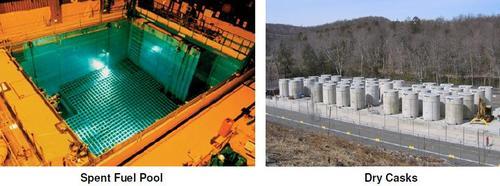
On June 15, UCS submitted comments to the NRC on the recommendations of the post-Fukushima Task Force for expedited transfer of spent fuel to dry casks.
UCS supports the accelerated transfer of spent fuel from pools to dry casks. A chief advantage of such transfer is to increase the safety margin for events (either severe accidents or terrorist attacks) that cause a loss of water from the pool and result in heating of the spent fuel to the ignition temperature of the fuel’s zirconium alloy cladding, a self-sustaining zirconium fire, fuel damage, and massive radiological release.
The safety margin could be increased through enhancing defense-in-depth by strengthening the passive safety response of a pool to such events. It is remarkable that the nuclear industry and the NRC point to the so-called passive safety features of new nuclear reactors as a major advantage over the current generation, yet for operating reactors they oppose making modest changes that could enhance the passive safety response and reduce reliance on active measures to respond to a spent fuel pool fire. Such passive safety measures would be desirable for situations, such as Fukushima-type events, when active mitigative measures might not be able to be used quickly or effectively.
To increase safety, we find that:
- the spent fuel in spent fuel pools should be configured to minimize the risk of a zirconium fire if active safety measures are not available, by maximizing the potential for cooling by natural air circulation,
- the spent fuel should be configured so that even if ignition does occur in hotter fuel assemblies, there is little risk that the fire will propagate to cooler assemblies,
- the amount of spent fuel in the pool should be reduced to limit the radiological release, in the event the fire does propagate to cooler assemblies.
The NRC does not believe that expedited transfer of spent fuel to dry casks is necessary, given that following the 9/11 attacks it required licensees to disperse hotter spent fuel throughout the pools in a so-called “1×4” configuration (if feasible) and to install emergency means for providing makeup cooling water.
However, the NRC has not substantiated this belief by providing the public with sufficient technical information to demonstrate that these measures are sufficient to reduce the risk to an acceptable level. The NRC has conducted both analytical and experimental studies on spent fuel pool fires in the last decade but most of the results of these studies are classified or otherwise withheld from the public.
UCS believes that the scant information that has been released on these issues to date supports our view that the uncertainties in pool fire analysis are so large that substantial safety margins are needed to maintain defense-in-depth. These margins can be achieved only by reducing the pool inventory well below the densely packed configuration that the NRC currently advises licenses to maintain.
